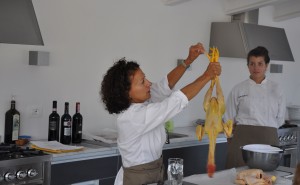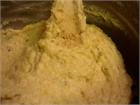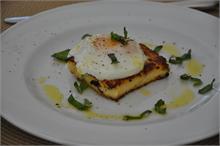I first met Geraldine Sarnataro – or Chef Gerri – about five years ago at The Institute of Culinary Education in Manhattan, where she teaches professional level pastry arts, culinary classes and a variety of specialty classes on bread making, pizza making and Italian home cooking. I was working as their in-house PR Manager, and she was a Chef-Instructor at the school. I gravitated to her passion for food and her entrepreneurial spirit instantly, and always enjoyed working with her on press opportunities, and sitting in on her classes.
In addition to teaching, Gerri is founder of Cucina della Terra, her very own cooking school located in Umbria, Italy. At Cucina della Terra, she is fulfilling her longstanding dream of sharing her love for Italian food, culture, and landscape and offers these amazing week-long cooking vacations. (Talk about bringing your passion to life, right?!)
It is my goal to get to Umbria with my family and take part in one of these hands-on cooking excursions. But in the meantime, let’s bring a little bit of Umbria to our own kitchens stateside, with this delightful look at one of my favorite grains – polenta!
I absolutely love polenta – especially in the Fall and Winter months – and love to pair it with hearty stew or oven-baked chicken and tomatoes. There’s something so heavenly about the taste of crushed tomatoes or savory braised meat over polenta and it’s the type of food that just kind of envelops you (when I need my food to hug me back, I whip up some polenta.)
The best part about polenta for me these days is that it’s a kid-friendly food! My son has been eating polenta since he is just under a year old. Older kids might like the finger-food version of this versatile grain – cut-out in their favorite shapes or cartoon characters and pan-fried.
So please enjoy this below “Polenta Primer” thanks to Chef Gerri and Cucina della Terra. And if you’re interesting in checking out her cooking vacations in Umbria, click here. (Tell her mom a la mode sent ya!)
Polenta: A creamy alternative to pasta & potatoes
by Chef Geraldine Sarnataro
http://www.cucinadellaterra.com
Warm. Hearty. Creamy.
If grits & ham get your juices flowing, you may find the ground corn– polenta (farina di granturco) of Italy– a pleasant and surprising alternative.
Buying polenta
It’s worth hunting down the best. Look for polenta that has been imported from Italy. The variety of corn (flint) is different from that used for US cornmeal or grits (dent corn or hominy). Imported polenta comes in various grinds, from course (bramata) to fine (fioretto). Read the directions on the package. Select the polentas that require 40 to 70 minutes to prepare. Marino, Moretti, or Nicoli are three imported brands from Italy available in the US at specialty markets or on-line.
Making smooth polenta
The ratio of liquid to grain is generally 4 parts liquid to 1 part grain. For a slower cook and creamier consistency, add more liquid, either hot or cold. You can use water, broth, milk or cream.
Lumpy polenta– a frequent complaint– is really easy to avoid. Simply bring your liquid to a rolling boil in a heavy-bottomed pot and only then, slowly pour the polenta into the boiling liquid and whisk away. Once you have added all the polenta grains and continue whisking, they will begin to swell. Then, you can switch from the whisk to a wooden spoon (bit of tradition here, or a guarantee that you won’t scratch an enamel-coated cast iron pot).
The polenta is done when it is creamy and free of a coarse grainy texture. Taste it throughout the cooking process, from beginning to end. You will enjoy a better understanding of making a perfect polenta
Serving polenta in a variety of ways
Once the polenta is cooked, the addition of grated cheeses, cooked bacon or pancetta, or herbs will give your polenta your own distinct flavors.
You can serve polenta soft as an accompaniment to braised meats, fish, or vegetables.
Tips For Cooling Polenta
To cool, pour the cooked polenta onto a buttered parchment-lined baking sheet. Place another sheet of buttered parchment on top of polenta. Lay another equal sized baking sheet on top. Press gently to even out the underneath layer. Put the baking sheets into the refrigerator. Make sure the polenta has become cool and firm before you attempt to unmold and cut it. Once the polenta cools and sets, you can use it for sauté, baking, and grilling.
Tips on Pan-Frying Polenta
After cooling polenta, cut with a cookie cutter (for those creative folks, yes, you can use hearts, triangles, or bunnies). Use a lightly-oiled non-stick skillet. Heat the pan- a drop of water will sizzle. Lay the polenta in the skillet and brown on both sides. Use a wide Teflon- coated spatula to flip the polenta.
Polenta Lasagna
Another delicious way to use square slices of cooled polenta is to layer them, lasagna style, with sauce and cheese. Then, bake the polenta lasagna in a 375 degree oven until the cheese melts and begins to brown.
Poached Eggs on Pan-Fried Polenta with Pancetta
A delicious dish for brunch.
{I was not compensated in any way for this post. All opinions expressed here are solely mine. Part of this content first appeared within a Cucina della Terra newsletter. mom a la mode received expressed permission from Geraldine Sarnataro to republish content on this blog.}






I definitely have to try some polenta – and plan a trip to Italy 🙂
Go for it! The good news is polenta is ridiculously inexpensive and easy to make. A trip to Italy…not so much 🙂 But if/when you do go, head to Umbria/Tuscany!
Love polenta! These are great ideas. One of my favorite meals is to use polenta instead of pasta with leftover gray & meatballs. Yummy!
Ohhh, that sounds DELISH!! Meatballs and gravy over polenta! Might have to try that soon!
I took a class with Chef Gerri at ICE. She was a terrific teacher – picked up a lot of great tips and ideas from her1
She’s pretty fantastic, right?! I can totally see you and your husband enjoying one of her culinary vacations!!!